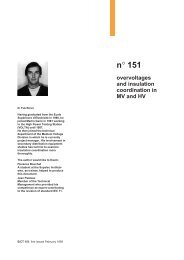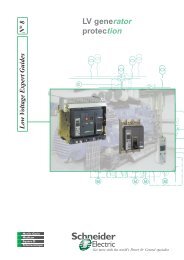Current transformer selection guide
Current transformer selection guide
Current transformer selection guide
- No tags were found...
Create successful ePaper yourself
Turn your PDF publications into a flip-book with our unique Google optimized e-Paper software.
<strong>Current</strong> <strong>transformer</strong> <strong>selection</strong> <strong>guide</strong>DETERMINATION OF THECUSTOMER’S NEEDSUMMARY1 - Electricalcharacteristics of theprimary circuits2 - IEC metering andprotection standards3 - BS specifications fordifferential protectionClient’s needs are determined by the electricalcharacteristics of the primary circuit, the use tobe made of the secondary circuits and thestandards used to define the CT.1 - ELECTRICAL CHARACTERISTICS OF THE PRIMARY CIRCUITS SUIVANTNORME IECThe primary circuits of the current <strong>transformer</strong> must withstand theconstraints related to the medium voltage network to which it is connected.☞ Remark : all the electrical characteristics used for CTs are definedin binder B, chapter 1, topic 3.Rated frequency (f) :This is the frequency of the installation.A CT defined for 50 Hz can be installed on a 60 Hz network with the samelevel of accuracy. However, the opposite is not true.For a non-referenced unit, it is vital to indicate the rated frequency on theorder from.Rated voltage of the primary circuit (U pn )General case:Insulation level continuity for the whole installation will be ensuredif the rated voltage of the CT used is ≥ the rated voltage of theinstallation.The rated voltage determines the insulation level of the equipment(see binder B, chapter 1, topic 1).Generally we choose the rated voltage based on the duty voltage, U s ,according to the following table:U s = 3.3 5 5.5 6 6.6 10 11 13.8 15 20 22 30 33date11/92- B•1•4 -revised08/95U pn7.2 kV12 kV17.5 kV24 kVSpecific case:If the CT is installed on a bushing or a cable providing insulation,the CT can be LV ring type.36 kVpage 2

















